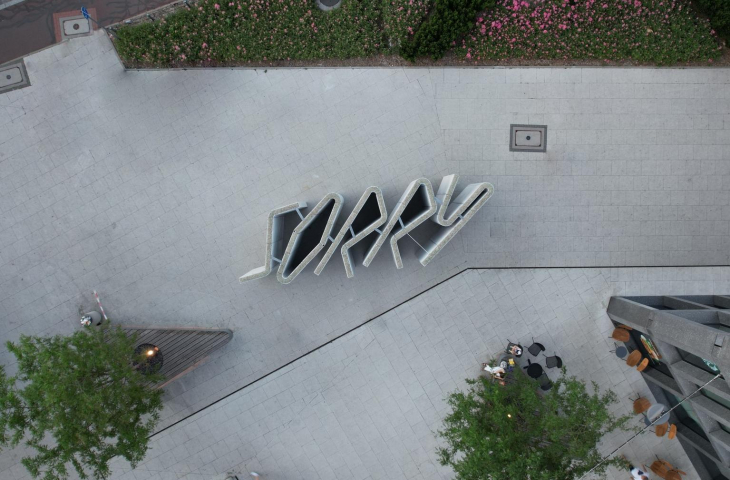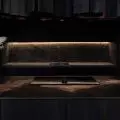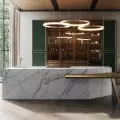Joanna Rajkowska's new installation is already standing in Poznan. It is a concrete wall - an oppressive illustration of the situation on the Polish-Belarusian border. But not only. From the level of the sidewalk - a barrier strewn with broken glass. Seen from a bird's eye view, it becomes a perverse message or commentary.
Rajkowska's new venture is the artist's second approach to the Poznan space, this time completed. Eleven years ago, the esteemed artist (known primarily, but not only, as the author of Warsaw's Dotleniacz and Greetings from Jerozolimskie Avenue, the so-called " Palm" on the de Gaulla trafficcircle) wanted to transform one of the chimneys of a former paper mill in the Old Town. She proposed that it take the form of a minaret, but this did not meet with the favor of decision-makers and some residents. The concept ended up in a drawer.
in two ways
This time Rajkowska created an installation that - directly - is meant to depict the situation on the Polish-Belarusian border, with the construction of a high fence, pushbacks and the accompanying official narrative, and in general - all kinds of oppression related to separation, segregation, inaccessibility or exclusion. In the very center of the city, at the foot of the Baltic office building (design: MVRDV) grew a concrete wall about three meters high with unusual undulating walls. Its top edge is formed by sharp, stacked, clearly visible pieces of broken glass panels. This is how a passerby sees the oppressive installation.
Installation "Sorry" by Joanna Rajkowska in Poznań, 1. Fenced installation two days before "unveiling", 2. Visualizations.
1. photo: Jakub Glaz, 2. organizer's mat.
The situation changes when one looks at the wall from above, such as the higher floors of a neighboring office building, or from a drone. The concrete elements form a "sorry" sign (see title illustration). An apology for the situation at the border? Not exactly. As Rajkowska said in an interview with Gazeta Wyborcza:
"The word 'sorry' is overused to the point that it means nothing. It is merely a phrase that allows us not to do something, not to make a gesture, not to settle accounts, not to face reality. Instead, it allows us to delete without consequence the problem that remains anyway. The word "sorry" has become for me a synonym for complete impossibility and even reluctance.
narrowly and unfriendly
And indeed, the word "sorry" seen only from above, from a distance, does not actually resound at all, it is "safe". It reflects well the form of empty conventional apologies, which are not followed by any action. The wall, set on the sidewalk, is first and foremost a barrier - oppressive and perverse at the same time. After all, through the narrow gaps between the element-lites one can observe snippets of reality on the other side. But it is impossible to squeeze through these gaps.
Installation "Sorry" by Joanna Rajkowska in Poznań, gaps between elements of the wall
photo: Jakub Głaz
However, an attempt to overcome the wall with the top will encounter the most dramatic barrier - the sharp shapes of "częstokołu" made of broken glass panels. Rajkowska points out that the other inspiration for the installation - besides the crisis at the border - washostile architecture (hostile architecture) directed against the homeless, which she had the opportunity to observe during her stay in the UK. She also adds that
The SORRY project was born out of a hunch that since the Holocaust we have not experienced, as a community, a more difficult moment testing our maturity, responsibility and solidarity
Installation "SORRY" by Joanna Rajkowska in Poznań, view against the background of the Bałtyk office building
photo: Jakub Glaz
the need for anti-monuments
The artist also often refers to her latest installation as an "anti-monument." She notes that she does not know
why we don't erect anti-monuments to various embarrassing corners of human history, collective mistakes, collective stupidity. Embarrassment is a powerful force.
Will Poznań residents have a chance to feel embarrassed in the vicinity of Rajkowska's installation? Yes, but - as it seems - it will not be a strong confusion. For the impact of the aptly conceived installation is somewhat weakened by its location. Despite its considerable size, the wall seems to disappear at the end of a wide passageway between the tall Bałtyk office building and the old printing house building, and at the very spacious Kaponiera traffic circle. It can be easily bypassed, and therefore - avoid the physical experience of restriction, exclusion or inaccessibility.
Installation "Sorry" by Joanna Rajkowska in Poznań, 1. Drone view of the walkway/plaza, a wall shaped like the word "sorry" - left, 2. View of the wall from the passage, from the south
1. organizer's mat., 2. photo: Jakub Glaz
Positioning the wall in a narrow alley or passageway, so that little space is left on either side, would enhance the horror of what Rajkowska is talking about. However, all is not lost. After the Poznan "unveiling" of the anti-monument scheduled for Wednesday, the wall is to be shown in other cities as well: including Warsaw - otherwise marked by the memory of real ghetto walls cutting into the city's fabric. Perhaps, then, the meaning of Rajkowska's installation will resound more clearly in other places.
Jakub Głaz






















































